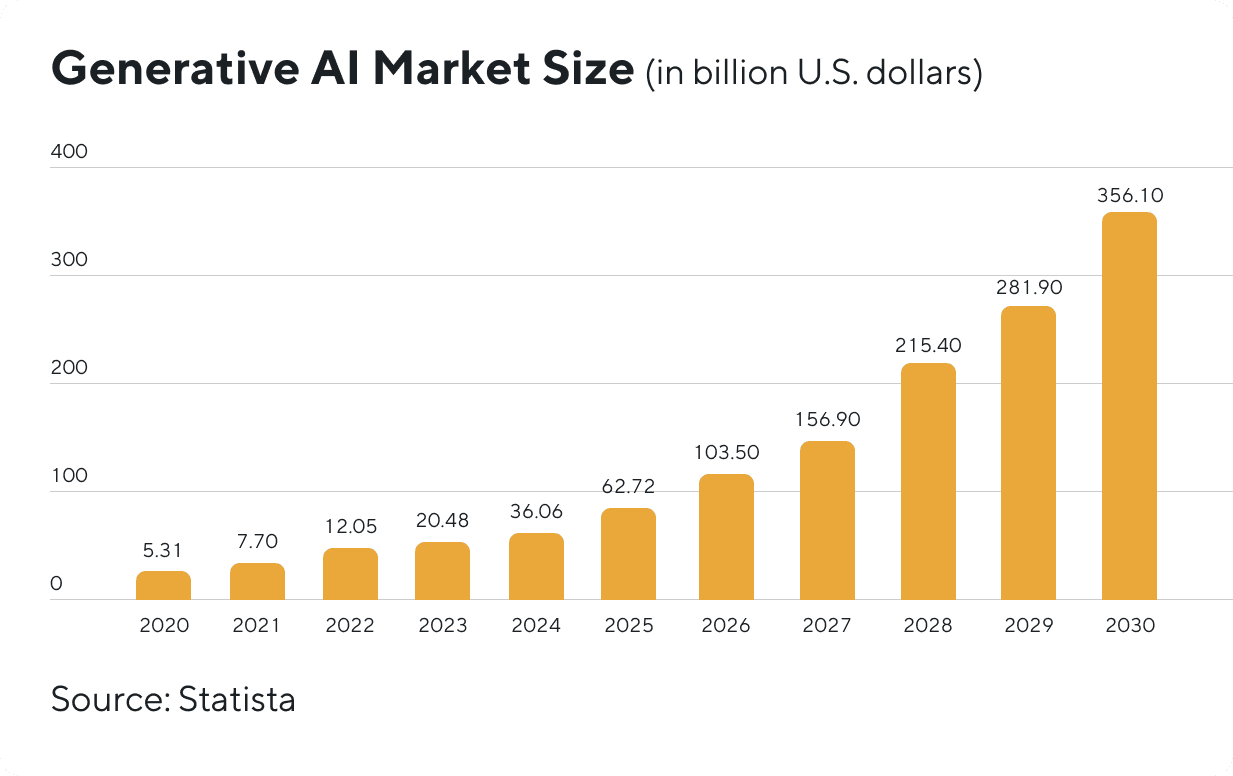When considering AI application in business, we first think of manual tasks, which robotic devices controlled by AI. But these days, we shift into the new reality. Software engineers can apply AI for many tasks requiring intelligent efforts, so they train AI systems, automate repetitive tasks, save human resources and costs, optimize business workflows, and elevate customer experience. Additionally, with predictive analytics, AI assists in forecasting trends, identifying patterns, and mitigating risks, enabling businesses to remain competitive in a rapidly evolving digital market.
Artificial Intelligence (AI) transforms businesses with systems that utilize
- Generative AI,
- Natural language processing,
- Voice recognition,
- Computer vision,
- Machine learning and deep learning.
AI-powered systems can be embedded in company’s hardware, like autonomous robots, self-driving cars, and drones, or they can be software-based, such as image recognition programs, virtual assistants, voice recognition tools, and facial recognition systems.
Businesses can apply AI solutions to boost efficiency in different processes and industries, from strategic planning to risk management, covering all business areas and transforming digital technologies.
- DK
- 15
- FI
- 14
- LU
- 14
- BE
- 14
- NL
- 14
- MT
- 14
- DE
- 12
- SI
- 12
- AT
- 12
- SE
- 12
- ES
- 10
- IE
- 8
- HU
- 8
- PT
- 8
- SK
- 7
- CZ
- 6
- FR
- 6
- EE
- 5
- IT
- 5
- LT
- 5
- LV
- 5
- PL
- 4
- RO
- 2
Source: Eurostat
How Can Generative AI Transform Your Business Processes?
Generative AI, as a subset, uses existing data to create different content for various industries. As you may know, traditional AI helps recognize patterns and make decisions based on predefined rules. Generative AI uses machine learning models to generate outputs, such as text content, pictures, music, and videos. It uses deep learning, particularly neural networks, to comprehend and replicate complex patterns given in the training data.

The Generative AI market size is predicted to show an annual growth rate (CAGR 2024-2030) of 46.47%, resulting in a market volume of US$356.10bn by 2030.
Source: Statista
What Type of Content Can Generative AI Models Create?
| Text Content Articles and Blog Posts Social Media Posts Product Descriptions Marketing Copy Personalized Recommendations Creative Writing (stories, scripts) Technical Documentation Brief Summaries from Long Reads Emails and Newsletters Chatbot Conversations Academic Papers and Reports | Visual Content Images and Photos Illustrations and Drawings Graphic Designs Memes and Social Media Graphics Product Images Architectural Designs Product Design and Prototyping |
| Audio Content Music Compositions Sound Effects Podcasts and Audio Stories Audio Branding Video Content | Animated Videos Video Clips and Reels Special Effects and CGI Video Summaries and Highlights Interactive Video Content |
| 3D Content 3D Models Virtual Reality Environments Augmented Reality Objects 3D Animations | Code and Analytics Source Code Generation Automated Code Documentation Game Development Assets Creating scripts to test code Bug detection Perform data entry Analyze massive datasets |
Industries Examples Benefiting from Generative AI
Fitness and Sportech
Generative AI has changed the sports and fitness industries, boosting engagement and changing many people’s lifestyles. Generative AI algorithms analyze user performance data, fitness levels, and goals to create customized training plans. Personal progress changes fitness plans, ensuring optimal results and reducing the risk of injury.
Example: Generative AI powers virtual coaching platforms that provide users with expert guidance and feedback with options like technique correction and offering motivation.
Manufacture
Generative AI transforms manufacturing by optimizing production processes, improving product quality, and reducing costs. It can generate efficient production schedules and identify potential maintenance issues before they occur.
Example: AI generates predictive models to help forecast equipment failures, allowing for timely maintenance and reducing downtime.
Retail and E-commerce
Generative AI improves retail customers’ shopping experiences by providing tailored recommendations and focused advertising. Additionally, it helps enhance supply chain management and inventory control.
Example: E-commerce platforms utilize artificial intelligence (AI) to recommend products based on consumer browsing and purchase history.
AI and Digital Transformation in Marketing: Illustrative Case
| Generative AI | Classic AI/ML | Narrow AI |
|---|---|---|
| AI-generated content and images Chatbots Personalized email campaigns AI-powered chatbots Marketing strategies A/B tests text and image content | Data collection and analysis Customer segmentation Trends, customer behaviors, needs, preferences, predictions Social Media Analytics Sentiment Analysis AI Insights Marketing campaigns analysis | Voice bot Virtual Assistants Recommendations |
How to Automate Your Business Using AI?
Businesses eagerly integrate rapidly advancing technology, understanding benefits and elevated final results, and focus on how to leverage AI effectively. AI’s ability to elevate business operations, offering specific applications by providing deeper insights and automating repetitive tasks, allows companies to free up employees to engage in distinctly human activities.
The initial step in integrating AI into your business operations is to identify how various AI solutions and types align with your key goals and how they can help achieve desired outcomes for your business.
As a client, you can find a dedicated team to develop AI-automated customer service workflows using customized models based on your data.
As a result, you can get AI-driven chatbots, tailored product recommendations, personalized content, and other AI functionalities that can address your customers’ needs.
Focusing on how AI can optimize critical workflows and systems, such as inventory management, supply chain management, client interaction with your product or services, and cybersecurity, can benefit each stage of your business operations.
Industries AI-Use Cases
Healthcare
AI algorithms assist in diagnosing diseases after medical images and patient data analysis. They recommend personalized treatment plans, taking into account individual health history, genetics, and lifestyle. AI-powered solutions can handle administrative tasks, reducing the workload for healthcare staff.
Finance
Data analytics help analyze transaction patterns to detect and prevent fraudulent activities. Thanks to machine learning models financial businesses can identify anomalies and suspicious transactions in real time.
Financial companies assess the creditworthiness of individuals and businesses and help execute trades optimally. As AI models analyze vast market data, processing them faster than human traders.
Logistics and Transportation
AI-driven analytics define traffic patterns and weather conditions to optimize delivery routes. It helps reduce fuel consumption and improves delivery times.
Autonomous vehicles driven by AI eliminate human errors, improving transportation safety. AI can also monitor and manage fleets of vehicles and maintenance schedules, improving overall efficiency.
HR and Recruitment
AI automates recruitment by scheduling interviews and conducting initial assessments of the screened resumes. AI solutions ease HR managers’ overall hiring process and improve the quality of hires. AI-powered systems can also guide new employees through onboarding, helping them complete all necessary paperwork and training.
Telecommunication
AI algorithms analyze network traffic to optimize performance and reduce congestion. This ensures better service quality for users.
Chatbots and virtual assistants answer customer inquiries, improving response times and, therefore, customer satisfaction. Also, AI can detect fraudulent activities like account takeovers and unauthorized usage, protecting customers and the company.
Education
Teachers improve their approach to each student, using AI solutions, which create personalized learning plans for students, adapting to their individual strengths and weaknesses.
AI also serves as a valuable assistant, handling administrative tasks such as grading, scheduling, and student enrollment. This relieves educators from these burdens, allowing them to focus on their subject-teaching. Students also use help from virtual tutors, who answer questions and explain complex concepts.
InsurTech
AI provides risk assessment and underwriting processes by accurately analyzing vast amounts of data. Machine learning algorithms can evaluate historical data, market trends, and individual customer information to determine risk levels and calculate premiums more precisely.
AI-powered virtual assistants understand customer requests, process claims, and provide policy information 24/7.
Real Estate
AI-powered tools analyze location, market trends, property features, and historical sales data to produce accurate property valuations that help buyers, sellers, and real estate agents make informed decisions.
AI’s predictive capabilities extend to real estate property maintenance. Analyzing data from IoT sensors and historical maintenance records lets you know when your property needs redecoration or maintenance. AI-powered platforms analyze buyers’ and tenants’ preferences, budgets, and behavior to recommend real estate that matches their needs, enhancing the property search experience.
Software Development
AI tools can automatically generate code snippets or entire codebases based on predefined parameters and requirements. These tools use ML models to identify coding patterns, helping developers write cleaner code.
AI in software development helps identify potential bugs, predict where errors are likely to occur and suggest fixes, reducing the time spent on debugging. AI can also automate various testing processes, including unit, integration, and performance tests.
Artificial Intelligence vs. Traditional Process Automation
Artificial intelligence and traditional automation are two approaches to improving efficiency in business workflows. Although both aim to reduce manual work and enhance performance, they do it differently.
AI creates systems that perform tasks that typically require human intelligence. These tasks include learning from data, recognizing patterns, and gaining insights to help with decision-making and offering personalized customer experiences.
Traditional automation uses predefined rules and programmed sequences, automating repetitive tasks without deviation, and does not learn or adapt independently.
| AI Automation | Traditional Automation |
| Continuous Learning Capability | |
| AI systems can learn from data and experience, using machine learning algorithms to improve their performance over time. | Traditional automation systems do not learn; they just follow a fixed set of instructions. |
| Adaptability | |
| AI can adapt to new situations and handle variations. It can modify its actions based on new data or changes in the environment. | Traditional automation performs well in stable, predictable environments but struggles with changes or exceptions. |
| Complexity of Tasks | |
| AI excels at handling complex and unstructured tasks, processing large volumes of data, recognizing patterns, and making decisions in business operations. | It is best suited for simple, repetitive, and structured tasks. |
| Decision-making | |
| AI systems’ competitive advantage is to make decisions based on data analysis and predictive modeling. They can evaluate multiple factors and predict outcomes. | Traditional automation does not make decisions. It follows predefined rules and executes tasks without any analysis or evaluation. |
| Integration Costs | |
| AI technologies require significant data, computing power, and expertise. However, the investment can lead to substantial long-term benefits. | Traditional automation is generally simpler and less expensive to implement. |
Final Insights
Artificial intelligence significantly impacts operational efficiency in business by automating tasks, optimizing workflows, and enhancing customer experiences. AI technologies, such as Generative AI, natural language processing, voice recognition, computer vision, and machine learning, are used across various industries to provide a customer-centric approach, streamline processes, and improve data collection efficiency.

FAQ
What is Narrow AI?
Narrow AI (ANI) refers to AI systems designed to perform a singular cognitive function. These systems can only learn or apply knowledge for their specific purpose. ANI uses advanced machine learning and neural network algorithms to achieve high-performance levels within their domain.
NLP is a prime example of narrow AI using technologies like speech recognition and text analysis. Virtual assistants like Siri and Alexa use it to interpret voice commands and provide relevant responses.
Image or Facial Recognition Software helps identify objects, people, and scenes in images. This technology is used in security systems and social media platforms.
Self-driving cars are autonomous vehicles that use narrow AI to navigate roads and recognize obstacles.
AI Virtual Assistants use narrow AI to set reminders, send messages, and answer queries.
What is Generative AI?
General AI (AGI or Strong AI) performs any intellectual task that a human can do. AGI aims to replicate the multifaceted nature of human cognition, encompassing reasoning, problem-solving, and the ability to learn across various domains.
What is Artificial Superintelligence?
Super AI (ASI) remains a theoretical concept that may surpass all aspects of human intelligence. ASI is predicted to emerge once AI systems achieve general intelligence and continue to self-improve rapidly. This level of AI would possess superior problem-solving abilities, creativity, and decision-making skills far beyond human capabilities.
What is Reactive Machine AI?
It’s the most fundamental type of AI. These systems can respond to immediate inputs but cannot store memory or learn from past experiences. They operate based on predefined rules and algorithms, making them suitable for straightforward, repetitive tasks.
What is Limited Memory AI?
Limited Memory AI can store and use past data to make informed decisions. These systems learn from historical information and improve their performance over time. Deep learning is a core component that enables AI to mimic neural networks in the human brain.
What is Computer Vision?
Computer Vision is a field of artificial intelligence (AI) that enables computers and systems to extract meaningful information from digital images, videos, and other visual inputs. This technology mimics the human visual system to recognize and analyze visual data, making it possible for machines to interpret the visual world.


